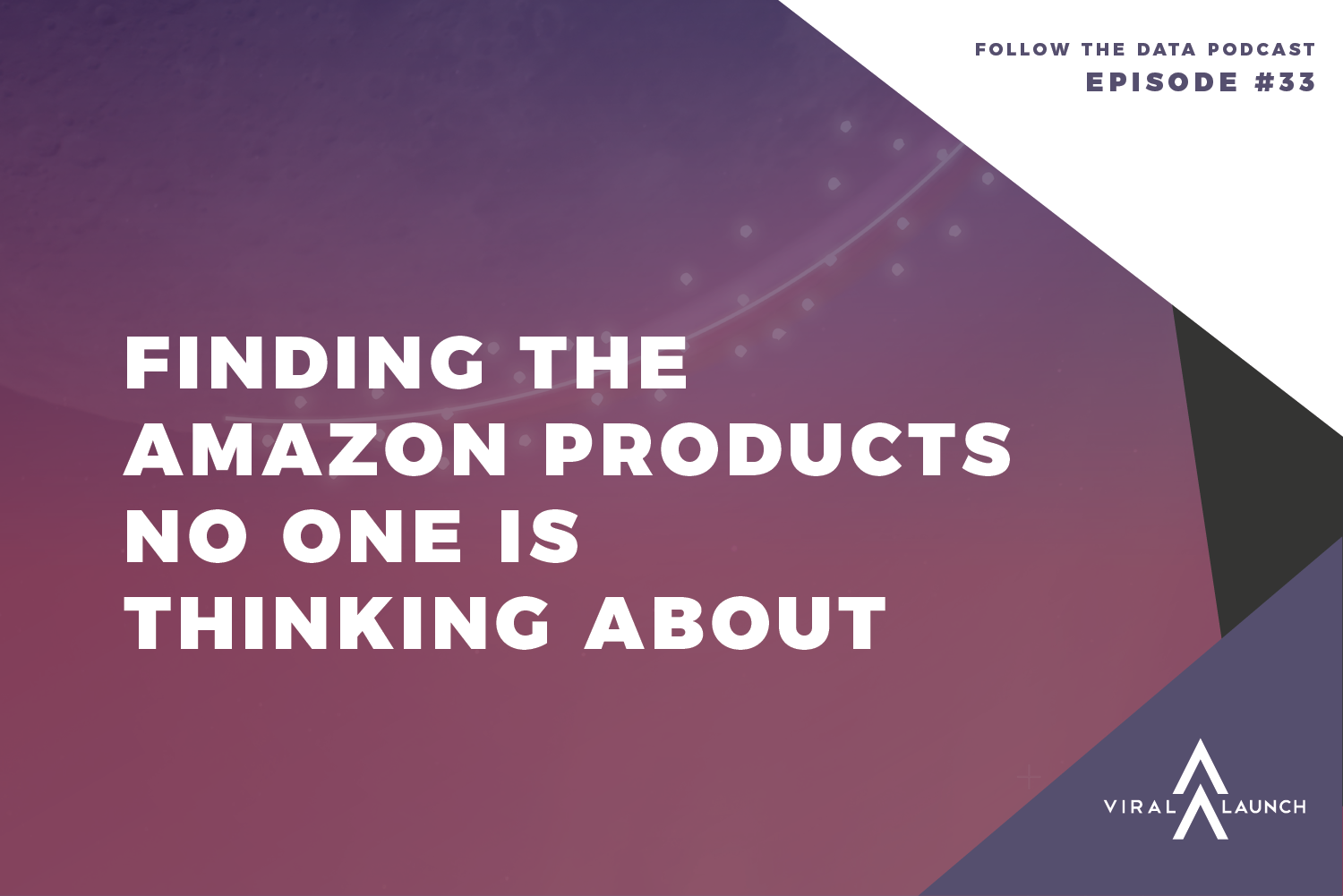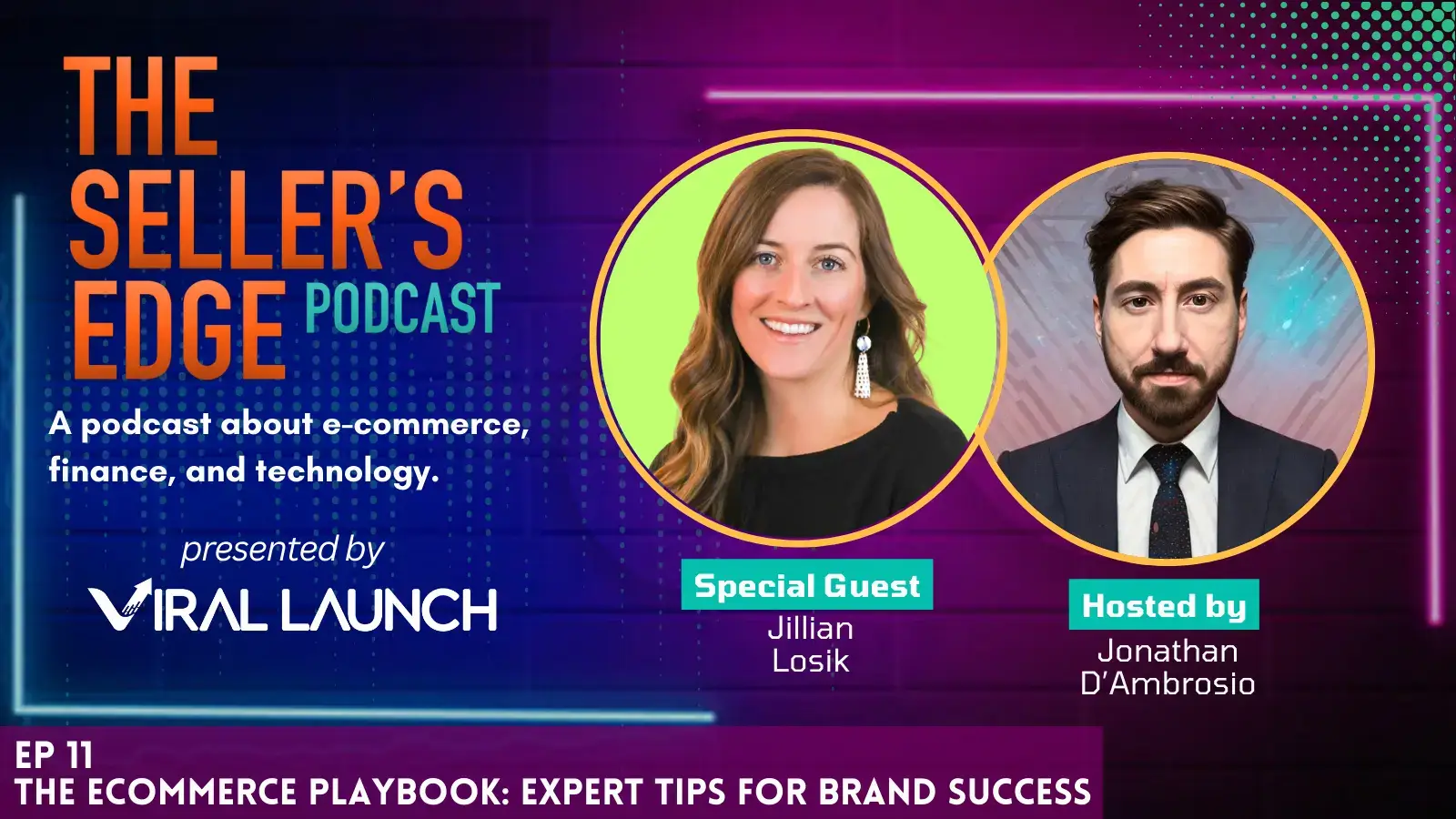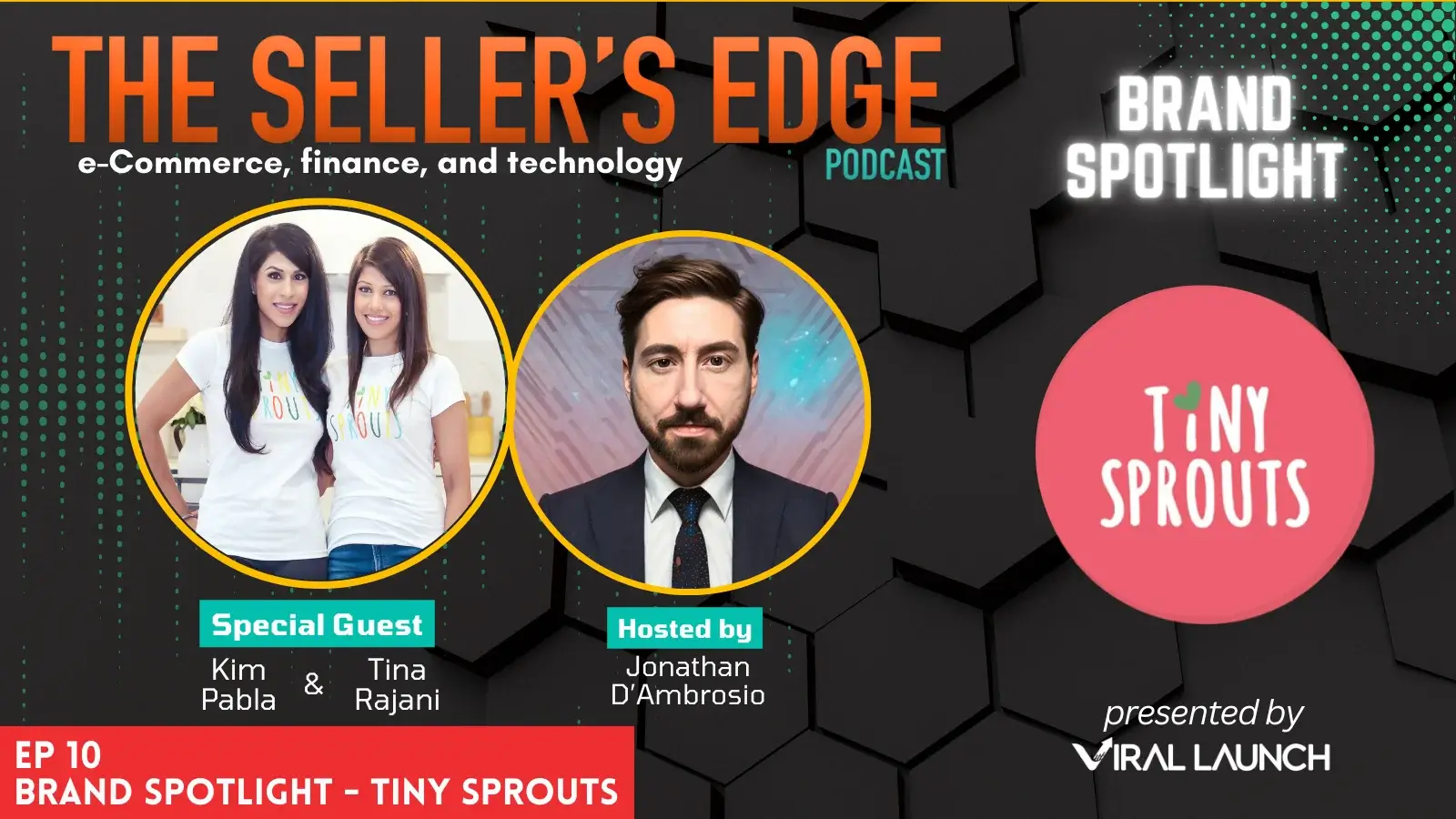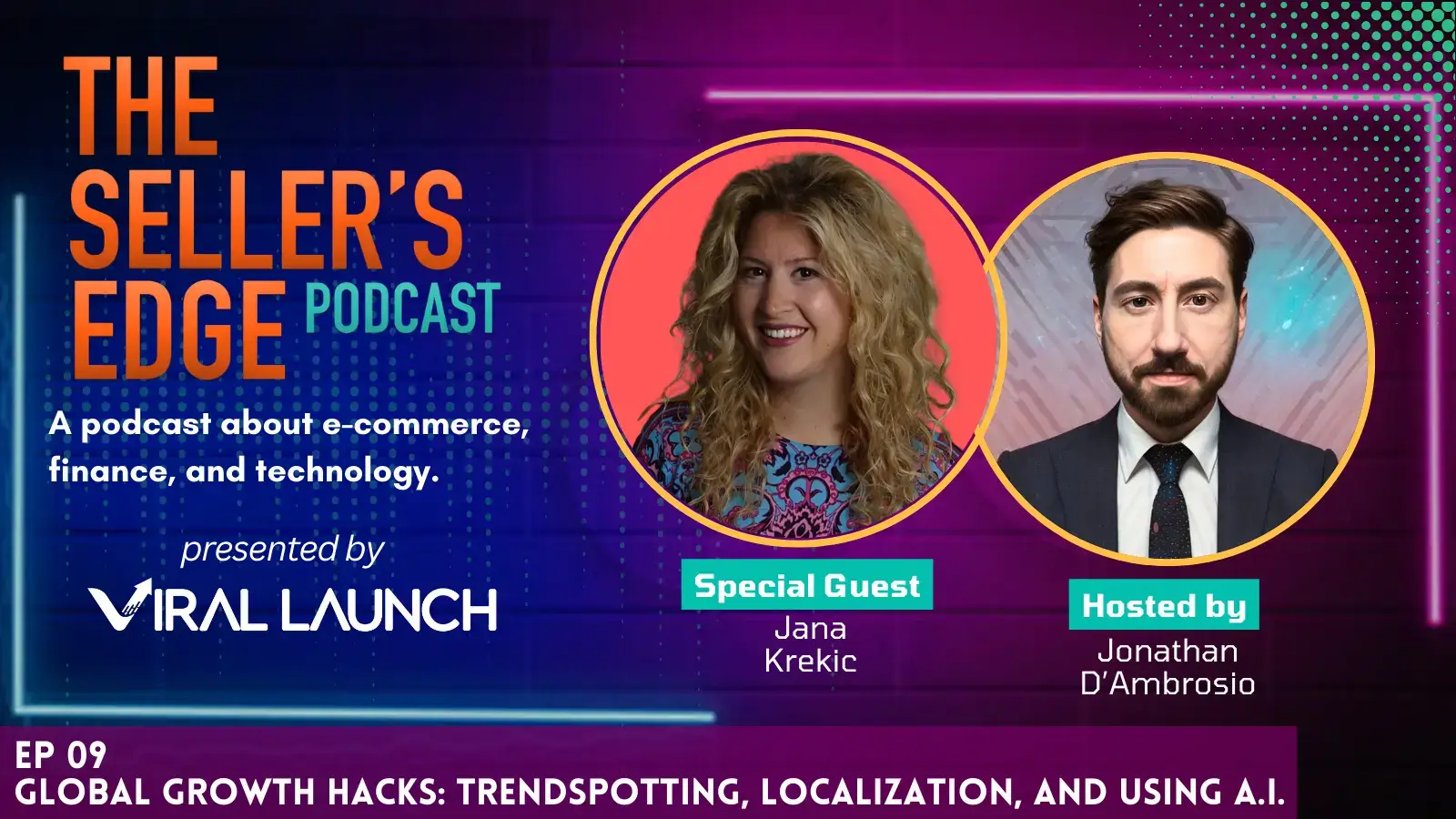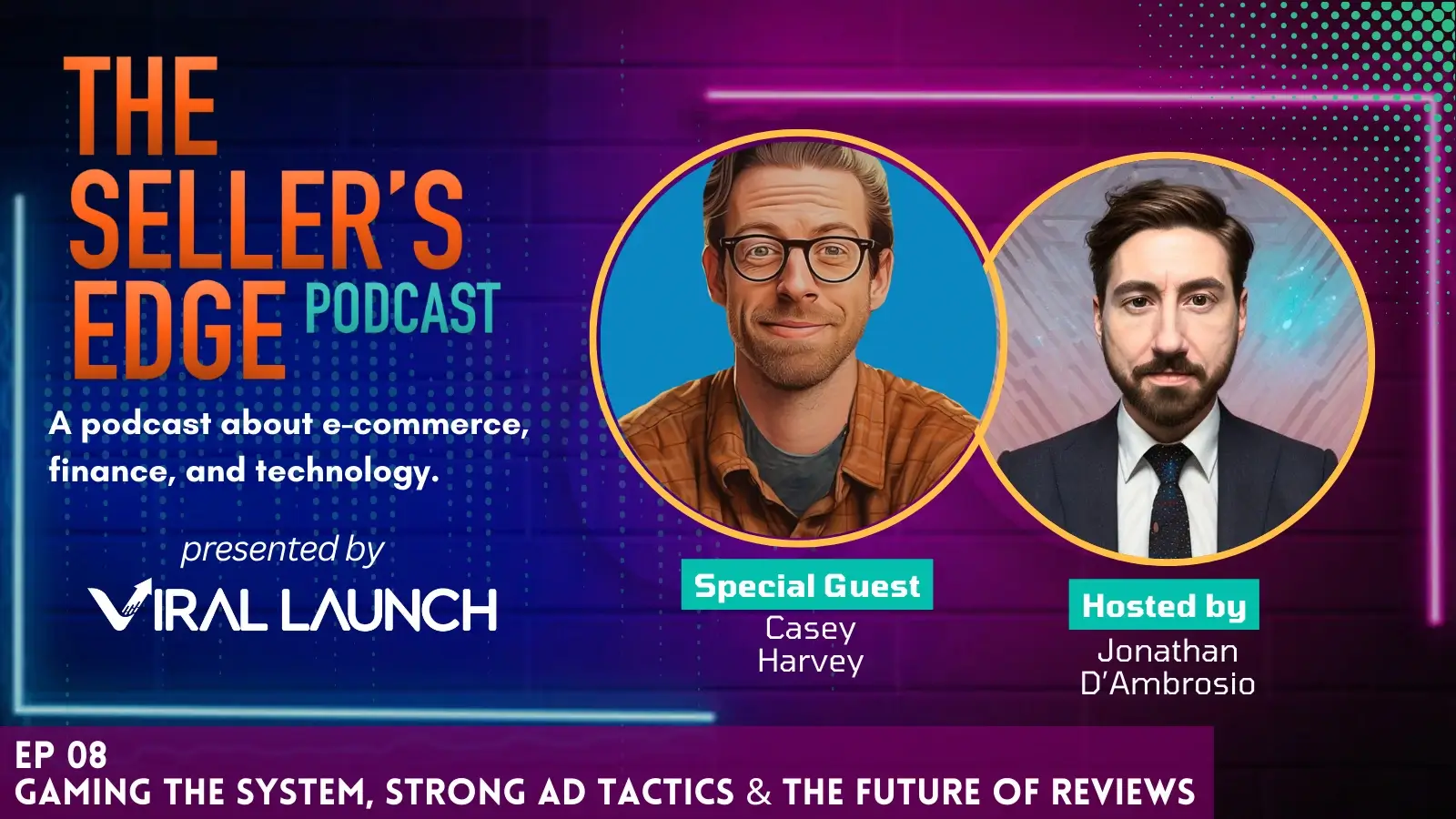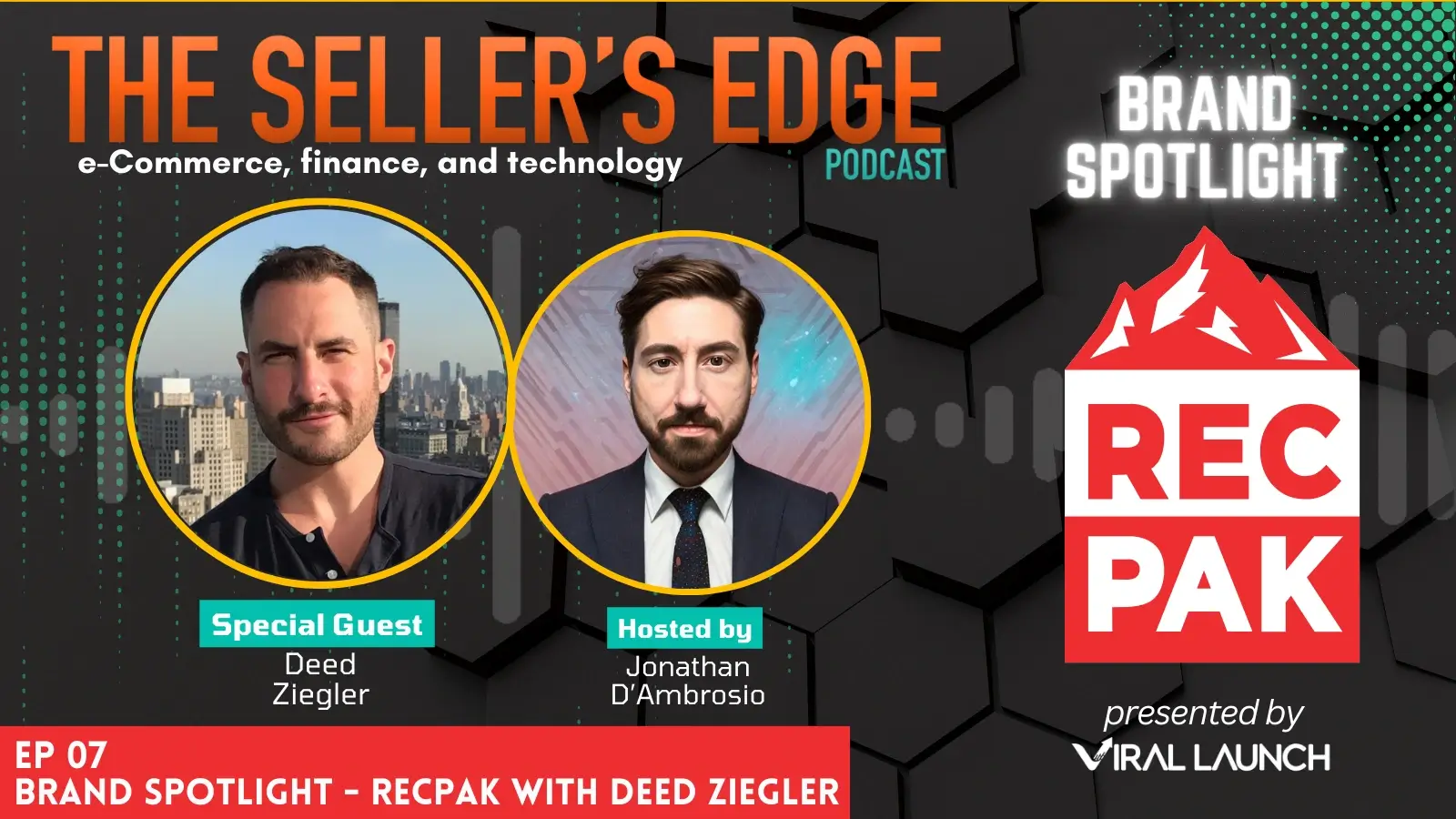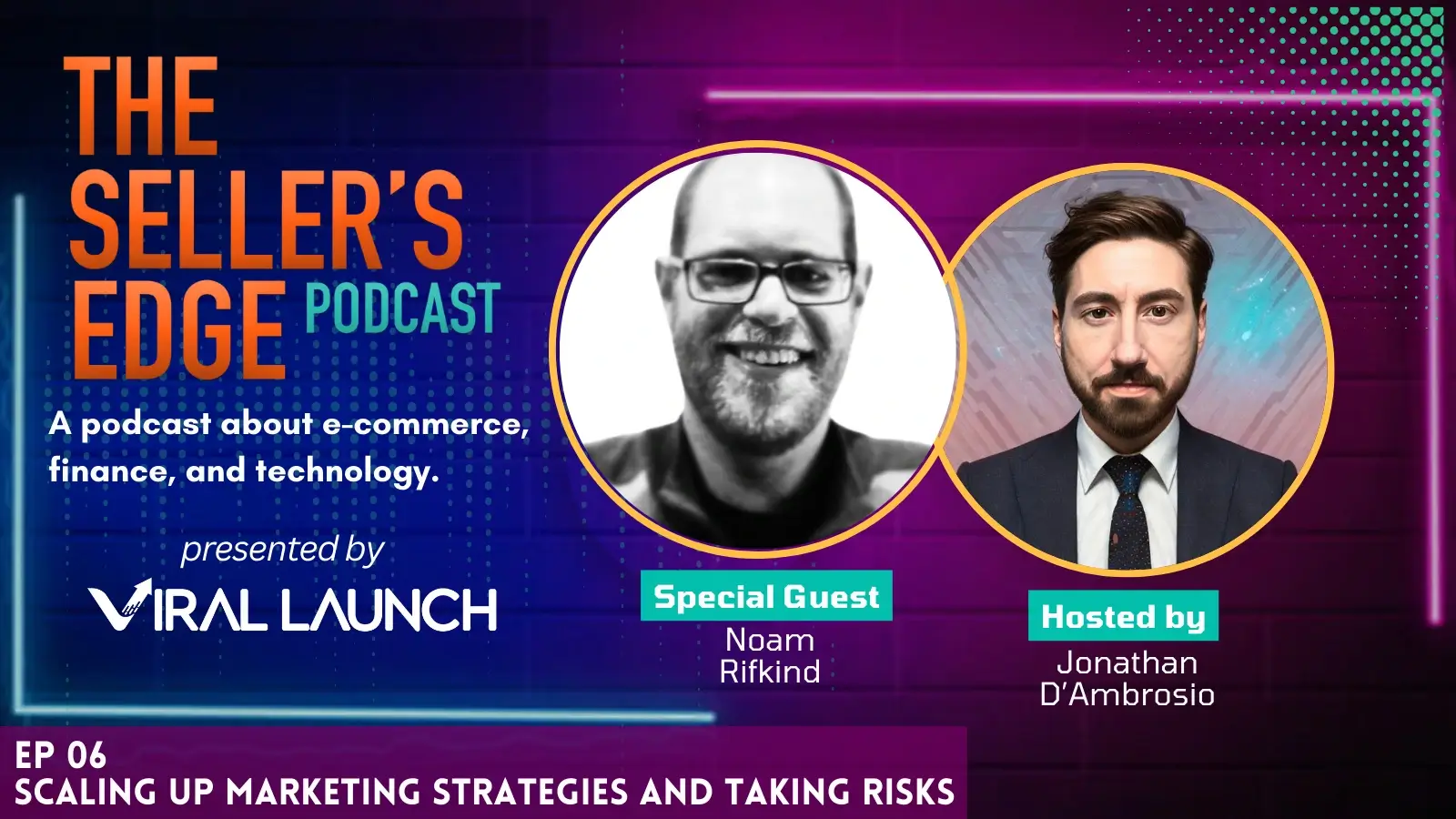Finding The Amazon Products No One Is Thinking About (Follow The Data Ep. 33)
Finding new markets or products to source on Amazon can be a challenge. Expanding your search methods, however, may prove to be extremely beneficial. On this episode, Casey and Cameron talk about how to shift your mindset in order to find the products on Amazon that no one else is thinking of. Casey and Cameron talk through the state of the Amazon market, as well as some specifics when it comes to the hunt for these new markets.
Listen on iTunes Listen on Stitcher
Podcast Transcript
CAMERON YODER:
Competition is increasing on Amazon. New sellers are entering the space, and experienced sellers are doubling down on their efforts to increase revenue.
CASEY GAUSS:
Finding new markets is more challenging today than it was two years ago. Even though it may seem like all the great opportunities have been taken and competition is too fierce, amazing opportunities are still out there, and they’re just waiting to be found. The trick is knowing what to look for. I’m Casey Gauss.
CAMERON YODER:
And I’m Cameron Yoder, your hosts for Follow the Data: Your Journey to Amazon FBA Success. In this show we leverage the data that we’ve accumulated at Viral Launch from over 30,000 product launches and our experience working with more than 8000 brands to help you understand the big picture when it comes to Amazon and, more importantly, the best practices for success as an Amazon seller.
CASEY GAUSS:
In this episode we’ll show you how to find unique product ideas and markets that the majority of sellers are not trying to compete in. Let’s get started.
CAMERON YODER:
Casey, today we’re talking about kind of the state of the market a little bit and kind of maybe how to react to that and how sellers should be reacting and maybe what they should be looking for when considering going into new markets.
CASEY GAUSS:
Yeah, so I think this is a perfect podcast to show off a couple of cool stats that Amazon just released in their letter to shareholders. So it was released this week at the time of recording, and there’s two things I want to point out. One, in terms of competition increasing, Amazon said that in 2017 alone there were 300,000 new sellers entering the market on the marketplace side, on the third-party side. So that doesn’t include major brands coming in and starting to sell as well. So if that doesn’t go to show you that competition is going to increase, you know, I don’t know what will. And to that what isn’t being shown here is more and more are we getting approached by private equities or, you know, people that are entering the Amazon space by coming in and purchasing these brands and trying to, you know, roll them up or really trying to put some money behind some of these brands or these Amazon businesses so that they can propel them forward with this new capital.
And so from all sides, you know, the Chinese are becoming more sophisticated. They’re doing, you know, greater degrees of black hat activity, like competition is coming from everywhere. So this is why in every way that you operate your Amazon business you need to continue to increase the degree of sophistication with which you are running. You need to be focused on higher-level strategies as well as these, you know, tactics that are data-driven, that are driving your results. No more can you just throw a bunch of stuff up against the wall and, you know, just work with whatever sticks. You don’t understand the reason why. Like you really have to be dialed in.
CAMERON YODER:
It’s easy for – I think it’s easy to get lost in the idea that there aren’t new products or aren’t good markets anymore to find because you’re seeing all this competition entering the market and/or you’re seeing just a ton of black hat activity like crazy stuff happening in the market, and it seems like it’s almost impossible to enter, but it’s not.
CASEY GAUSS:
So stat number two, to Cam’s point, is that Amazon has exceeded 100 million paid Prime members globally. So I don’t think that they share numbers in the US. I don’t remember the source, but I think last year there was an estimate that it was around 80 million in the US, which would be pretty insane.
CAMERON YODER:
That’s a lot. Geez.
CASEY GAUSS:
The US population is like 320 million, or so last that I knew. So you know, that would be, less than a fourth– or that would be, you know, right around a quarter, and that’s individuals. So this is people that are, you know, in preschool, people that are, you know, in nursing homes, whatever, so I don’t know the number of US households. I think that’s the better number because last I knew the stat was somewhere around like 62% of American households have Prime. I’d be really curious to see what that is now. But all that to say – oh, and sorry, along with that Amazon grew their Prime membership more in 2017 than they have in any years prior, I’m assuming from number of new people versus, you know, percentage-wise. But regardless, that goes to show, yes, competition is increasing, yes, you have to be operating at a higher degree of sophistication. But at the same time Amazon is working very, very hard to open up or to increase your potential customer base. So that means more potential revenue for you, and that means that you – the pie continues to get bigger and bigger, and it’s your job to take a larger piece of that.
CAMERON YODER:
And really there are kind of two ways to kind of double down on revenue or increase revenue, right? Either you find a new product to sell, or you optimize what you’re currently selling. And in this episode we’re going to – we’re going to kind of try to just introduce a method of rethinking, rethinking how you see and think about different aspects on Amazon and maybe how you research for new products. And this could apply also to optimizing your current products, but we’re going to talk today about changing mentality with entering new markets or discovering new markets to enter into.
CASEY GAUSS:
And the reason being is that, you know, just to provide context as to why this topic, again, is generally from what we see the fastest way to growing your top line revenue is by launching new products. I was just talking with a friend last night. These guys have been in it from, you know, 2015 and I was asking them how things are going, and they said you know, things are good, but our revenue has just been stagnant at the $1 million to $1.2 million mark for a long time now, and we’re just really trying to figure out how to get past it. And I know that they’ve actually been focused on a lot of like the Shopify and like building their brand, you know, diversifying, like all these hot topics that people like to talk about. But they haven’t been focused on launching new products, and you know, I said to him this is super common. I see this all the time, so you know, don’t beat yourself up over it. A lot of people make this mistake, and I completely understand why. But there’s no way that if you weren’t focused on launching products in 2018 your revenue would stay at $1 million to $1.2 million. If you’re continuing to launch products that are doing another $20,000 to $50,000 a month, then there’s no way that launching 10 of those isn’t going to significantly increase your top line revenue.
So with that, fastest way to grow your revenue is to launch products, assuming that you haven’t been doing a terrible job of that right now. If that’s the case then okay, running a launch or, you know, running some sponsored ads or AMS or something like that would significantly increase your revenue. All that to say product selection, super important. One of the best ways to grow revenue, especially if you’re in the, you know, seven-figure mark, then this is definitely the best way I think to grow your revenue. And so we wanted to touch on okay, in 2018 as things continue to become more competitive how do you increase revenue? How do you find those opportunities in the market?
CAMERON YODER:
So we’re going to talk about two main mentalities here, two types of products, okay? We’re going to break down what we’re going to call the quote unquote flawless product and the proxy product, okay? So the flawless product is what most sellers typically tend to go for, what they, the aspect of a product, so like the price or the size of the product that most sellers tend to go for. So that’s the flawless mentality, right, what most are going for. The proxy product is our suggestion to reconsider how you think about finding a product or the type of product that you’re looking for. In this case, one quick one, which is we’ll go into the – go into each of these, but it’s like instead of going for like the $15 to $30 product go for the lower-priced or higher-priced item, stuff like that.
So we’re going to introduce different topics like this. Just know the flawless, the flawless mentality is what most people are going for. The proxy mentality, the proxy product is what we’re suggesting to reintroduce your thought patterns to match. That’s not saying that you cannot find products or product markets in the flawless, quote unquote, area, right? We’re just suggesting to consider looking for proxy products and proxy markets. So as a whole we’re going to touch on five, five main areas for products. It’s going to be price or margin, sales or revenue, reviews, size and seasonality, okay?
So let’s just jump in with – let’s do price first. So the price, again, new markets, new products. Most people – the flawless mentality – most people tend to look for strictly like $15 to $30 items, right? In this case we’re suggesting to reconsider. And some of these are no-brainers, but you would be surprised how many people are not intentional about thinking about finding proxy products or get into a pattern of sourcing flawless products. So the proxy mentality, the proxy product in this case, would be either below – a less expensive product or a more expensive product, right? So with each of these a lower expensive product could mean higher volume. A more expensive product could mean higher or the same margin. The risk that comes with having a proxy mentality with a lower price or a higher price is that more expensive products sometimes mean more moving parts. So manufacture mess-ups or misrepresentations of quality honestly could end up ruining you, ruining your product on Amazon. So the good thing that comes with like a lower-priced item or a really higher-priced item is that there aren’t as many sellers in those spaces. However, there are trade-offs to risk. And competing on Amazon with high prices honestly can be difficult unless the market matches the average high price, right? So if you have a really good quality product that is more expensive, something like a $60 fidget spinner in a market that’s full of $10 fidget spinners, you will not be able to compete very well. You are less likely to compete very well.
So proxy, proxy mentality for price or margin is a lower price and/or a really higher price. The next area that we want to touch on is sales or revenue, right? Most people, flawless mentality, tend to look for products that are pulling in something like – this kind of goes in conjunction with price, but $10,000-$20,000 in revenue, right, which means high – typically a high amount of sales. So the proxy mentality here would be to look for something that has a lower revenue or a higher revenue. Ideally of course everyone wants to find a higher revenue.
CASEY GAUSS:
I think there’s two camps in the flawless. Either $10,000 to $20,000 or they’re looking for those $100,000, $500,000 products.
CAMERON YODER:
Super high, yes, yes, yes. And the mentality, what comes with really high revenue, which is what we want to talk about, what comes with really high revenue is really increased competition. Typically it’s – of course everyone, if we had to choose, like if you had to pick between entering a market or making $10,000 a month and/$100,000 or a month of course you’d want to pick $100,000 a month. However, $100,000 a month takes a lot more resources, much more competitive. It’s going to take a lot more from you to enter. So looking for those more expensive markets is good. Just know the risk that comes with that is actually being able to financially support your decision to enter in a market like that. And the risk that comes with something like a lower revenue is that you might have to source more products to match. Like let’s say your revenue goal is something like $15,000. Then maybe instead of just sourcing one product that makes $15,000 you’d have to find three smaller products each that are making or pulling in $5,000, right? The end result is the same. You end up making the same amount if they add up to $15,000. You just need to source more products.
CASEY GAUSS:
Generally the big sellers are not willing to enter into these kinds of markets, and so a nice opportunity for you to enter markets where competition is low. You don’t have people that can, you know, outspend you like crazy, people with budgets in the millions of dollars to outspend you. We have those types of clients, and it’s easy for them to come in and steamroll through markets because they can just spend as much money as they want on promotions on outside marketing to get sales, to get reviews. They’re not buying reviews; they’re getting enough sales so that reviews happen, and they’re just able to steamroll through. And you just cannot compete with those guys because they understand the strategy and they have the budget. So finding – I’m all about finding these markets with low competition because we see the worst of the worst, you know? Like people with the number one BSRs in, you know, some of the most competitive categories from cell phone cases, to beauty, to supplements, like it’s – we see it, and the amount of competition and the amount of fighting and resources literally spent just on battling competition is insane. And if you can avoid those, if you can find these markets literally even $5,000 if you could go in, spend no time getting it up there to doing $5,000 and just rinse repeat through tons and tons of products, yes, there’s overhead with managing them, but if you are comfortable with that, if you’re comfortable building out kind of the infrastructure, then there are so many things, so many headaches you’re eliminating by taking on that headache of more SKUs, essentially.
CAMERON YODER:
Exactly, exactly.
CASEY GAUSS:
And you’re so much better diversified.
CAMERON YODER:
Yes, yeah, you are well-diversified. Even staying in a similar market and/or branching out in different markets, like just having more products helps you diversify, set yourself up for success if one of them were to fall, where you can just pick up another. So that’s sales and revenue. Let’s move on to the aspect of reviews. Again, we touch on this a lot. Like most people – a really good review count to look for is something that’s low, right? Of course as low as possible, which you still should. You still should look for a low review count when trying to find new products and new markets because that’s a sign of low competition, right? I do think, however, that a lot of sellers tend to get hung up on not even considering markets that are just even slightly above what they would consider really low. What I’m saying now is not – I’m not telling you to go for markets that have really high review counts. I’m suggesting to even consider like bumping up your maximum, what you would consider your maximum review line. So if it’s like 100 maybe bumping it up to like 150 or 200. Even bumping it up to there, to something that you might not have even considered yourself able to enter into, you might find – you might, again, find more markets, more products that is just slightly – that review line is just lightly bumped up, slightly more competitive than the super, super low – basically I see sellers get hung up on trying to find markets that only have two, like an average of two or five reviews, which you still should be looking for. However, if you increase that to like where the average is 50, that’s still as so much prime for entry than something like an average of two or five reviews. So I would say like maybe expand, and just expand your limits a little bit, just a little bit, on the review count to open up your eyes at the very least to maybe what other markets are out there or what other markets you have not found yet.
And last, let’s touch on size. So we’re talking about size of a product. Again, we talked about this before, and this is kind of a – this is an easy one to think about, but like the flawless mentality is I need to find a product that’s small and lightweight, the shoebox mentality, small, lightweight product, which is good, of course. Like these are ideal scenarios, right, but we’re touching on things trying to get you, again, to just expand your thought process on what products to find and what products to pull up. In this case a proxy product would be something that’s, of course, large and/or heavy, right? In this case most people, of course, tend to stay out of those because there’s just more logistics involved. However, if you haven’t yet, at least consider entering into a product or a product market that is heavier or has larger items.
CASEY GAUSS:
Yeah, at the end of the day, I mean, I think the focus needs to be on the profit margin that you’re willing to – the profit margin that you’re looking for, right? So I see people say oh well shipping costs are so much higher for these products, and then it eats up all your margin. Well, actually a lot of times on these higher or larger products you are charging more. So if you’re making more top line revenue and the margin actually comes out the same but competition is significantly lower, in reality you’re going to be spending a lot less. Yes, there’s more capital associated with getting those products into the US and then shipping them through Amazon, but at the end of the day like if the margin – if the numbers make sense, follow the data.
CAMERON YODER:
Yep, exactly. And there are – there are five different categories of sizes to consider, small-large, small-oversize, medium-oversize and large-oversize. So there are a lot of areas that people don’t – aren’t even aware of our haven’t even considered. So consider even just looking into those.
So the last just kind of area maybe to focus on as a – with a proxy mentality is seasonality. And we actually just did – we just did an episode talking about seasonality and how to plan for Q4 specifically. But we run through just kind of a lot of strategy behind what goes into choosing a seasonal product over a typical or consistent product. And most people in the space, the flawless mentality is to pick a typical product, maybe one that’s just consistent throughout the year or more so consistent throughout the year. The proxy mentality would be to honestly go for something that is seasonal, and the risk, of course, with this is – and we go over this in the other episode – I’d really encourage you to check it out if you haven’t yet – is getting inventory right or basically not planning inventory well enough, which you could potentially lose out on money for. It is more risky than something like a traditional or a consistent product, but the benefit is just overall less competition. You can have some quick wins there, and it could be honestly a cash cow to fund getting into more competitive markets.
CASEY GAUSS:
And just to remind people, seasonality does not specifically refer to Q4. There is a season going on at pretty much every given time, whether it be the season of Easter, or Thanksgiving, or Valentine’s Day, or the summer, you know. And again, like yes, it is more risky, but if you use a tool like Market Intelligence – not that I’m plugging Market Intelligence – but like if you use a tool like Market Intelligence or whatever to help you identify what the potential volume is, how long does that spike happen, then you can really get a good feel. And maybe you, to play, if you really want to play it safe, then just undercut it. So you think that there is potential for, you know, 5,000 units to be moved over the course of two weeks for leading up to Valentine’s Day, then, you know, just source 2,500 or 3,000, and play the safe game. But you’ll still be able to make a lot of money. So there’s so many – basically the root of all of this is that there’s so many different ways to like skin the cat or whatever is the saying, and basically like you’ve got to figure out which way you want to do it. And the more willing you are to venture outside of the norm, the more likely it is that you will avoid competition and be able to find this great niche that works really well for, you know, you, your business goals, like maybe your lifestyle, your budget, yeah.
CAMERON YODER:
Even combining some of these proxy mentality products will allow you to maybe even find markets that are even more niche. So for example, if you find an oversized seasonal item, right?
CASEY GAUSS:
Yeah.
CAMERON YODER:
Like that’s – a seasonal item itself is kind of more of a niche thing, but when you go, when you take or put one more factor into that for consideration like an oversized seasonal item, you even kind of increase your chances of finding a market that other people are not in quite yet.
CASEY GAUSS:
Yeah, and again, just to remind everybody, the less the – for the proxy type products or venturing outside of the norm, I think it definitely requires a higher degree of due diligence in making sure that you are following the data to make sure you’re making the best decisions possible. But it is definitely out there.
CAMERON YODER:
Yes. There is one – there is one other aspect of products and markets that I want to touch on that honestly you might be really good for some people to enter into. Casey, just like you said, it might take more diligence. This one does take more diligence, but it’s markets that are design-oriented. So markets that are design-oriented basically are products that the sales for the products vary heavily based on design for those products. In this case if you have a design that is appealing to a lot of customers, then they’ll buy your product more. If you don’t, then you just won’t sell.
CASEY GAUSS:
My favorite example is 2015 baby bandanna bibs were popular. And we ran, you know, somewhere to the degree of 10 different baby bandanna bibs we ran launches for. And so it seemed like half of those baby bandanna bibs, we’d run a launch, they have good reviews, they have a good listing and so forth. We’d get them ranking, and then they don’t sell well, and they continue to drop down the ranks. And then the other five, we get them up ranking. They perform really well, and so it was at first such a mystery to me, you know, like these listings are great; why is this not working? The data, the data was showing us that it should be working. But one thing that you can’t quantify is the quality of the style or how, you know, other people respond to this particular style. Well, I guess you can quantify them in terms of conversion rate and stuff like that, but just looking at them from the outside in without having, you know, conversion data or whatever, or conversion from search to click into a listing, you don’t have that data, and so it’s very tough, or very at least intimidating for me who likes to make safe bets based on data to say like okay, we’re going to enter a design-heavy market, and we’re going to do everything right, and it’s going to turn out because the problem is yes, you could do everything right, have the best listing possible, have the best photos possible, just kill it in ranking and have good reviews. But if people don’t like your design people aren’t going to buy it. Or if, you know, the general population now doesn’t like this design, now the culture is appreciating this type of design, like –
CAMERON YODER:
The market – the market is the market is the market, right? Like in the end you can – you can guess as much as you can or are able to on what you think people are going to buy, what design people are going to buy. However in the end you cannot control the preference of the customers that are on Amazon looking for your design-oriented product.
CASEY GAUSS:
And I have seen plenty of instances – you know, there’s this one guy in the electronics space. He just had a killer designer, and he was – he was great at understanding consumer tastes, and he was able to, you know, put together great products that looked amazing and that people loved. And you know, I definitely applauded him because I’m more of a data person, not necessarily aesthetics.
CAMERON YODER:
And that’s – honestly I do see a ton of potential in design-oriented markets. I would, however, I would consider you to find these markets and maybe even consider outsourcing design to someone that is good, right?
CASEY GAUSS:
Yeah, yeah, yeah.
CAMERON YODER:
So just because you’re thinking like oh well I’m not really a designer so I can’t do design products, no, you can absolutely outsource design, even on something like Upwork, to get a good design and increase your chances of selling something like that. Again, it’s a risk, but it’s another area that I don’t think enough people have explored quite yet.
CASEY GAUSS:
Yeah, and if you are going the Upwork route just make sure that you are paying for quality. Make sure that you are getting feedback from your customer – target customer demographic. Don’t – and that does not include friends and family unless – yeah, it doesn’t really include friends and family. I think that’s an easy trap to fall into, but yeah, go spend the money on a great designer because it will pay off if you’re able to find, you know, these great market opportunities.
CAMERON YODER:
Overall just consider, consider expanding your product search parameters. Maybe get outside your comfort zone just to do even a little bit of research. We hear a lot of people say that they aren’t able to find new products or new markets right now. But maybe they haven’t tried expanding some of their parameters or some of their methods to find these products, these markets. Just kind of get out of that flawless mentality, get into the proxy mentality a little bit and see what you can find. You honestly might find a gold mine, a couple gold mines by looking in these expanded search parameter areas.
Hey, everybody, before we outro here I just wanted to share something new that we’re going to start with the podcast. We’re going to feature a question of the day for each of you to give input or insight on. So a question based on the topic that we’re covering that day basically. We want to hear from you, whether it be more questions on that topic or an answer to the question that we ask. We’ll read the question of the day at the end of each episode and answer one or a couple on next week’s episode. We plan on coming out with more direct response methods later for you to respond to. But for now just shoot us a message, a direct message on Facebook with a response to that question. If you message us directly we’ll get back to you and feature your questions or responses on the show. Also, also if you’d like to you can call in to leave a voicemail as a response. The number to call is 317-721-6590. Again, that’s 317-721-6590.
CASEY GAUSS:
So our question of the day is what is your biggest concern with selling on Amazon in 2018 amid all the changes in the market? Essentially, what keeps you up at night? Again, shoot us a message on Facebook and/or call in to leave a voicemail as a response.
CAMERON YODER:
If you know anyone that needs to simply gain perspective on finding those products that other people are not thinking of, share this episode with them. You can share directly from the podcast app if you’re on Apple, and literally like you can just text the link to someone. Our goal is just to provide valuable insight and data in regards to Amazon. So please, tell your friends, tell your family, and let them know.
CASEY GAUSS:
Thanks again, and remember, the data is out there.
